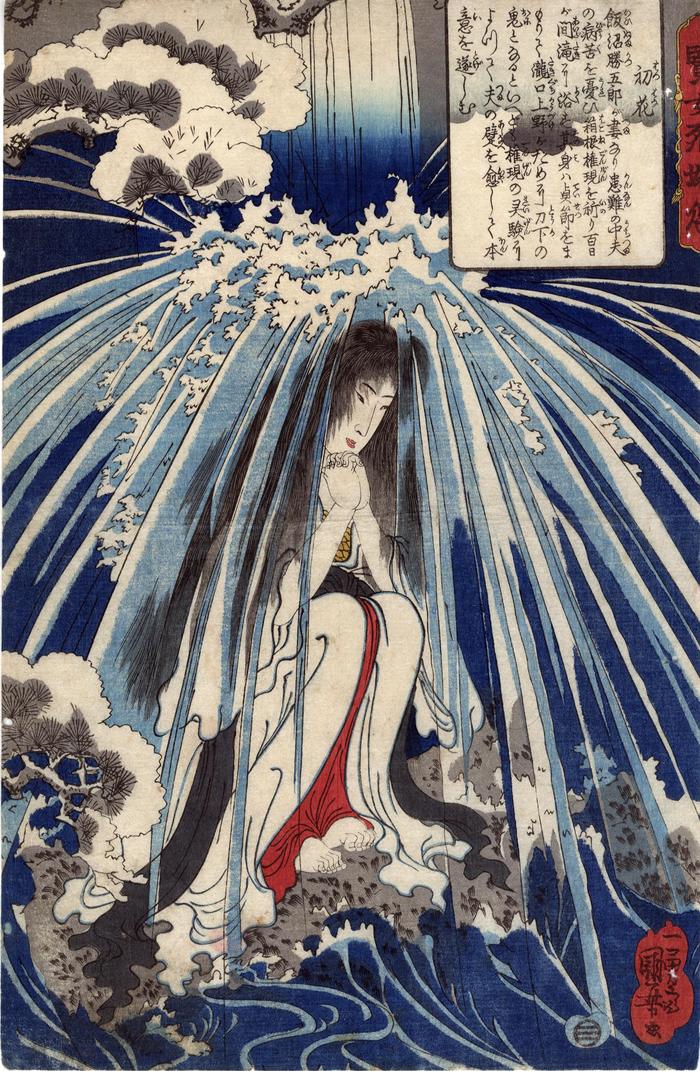Utagawa Kuniyoshi (歌川国芳) (artist 11/15/1797 – 03/05/1861)
Hatsuhana (初花 ) from the series Biographies of Wise Women and Virtuous Wives(Kenjo reppuden - 賢女烈婦傳)
ca 1841 – 1842
9 in x 13.75 in (Overall dimensions) Japanese color woodblock print
Signed: Ichiyūsai Kuniyoshi ga
一勇斎国芳画
Publisher: Ibaya Senzaburō (Marks 127 seal 08-067)
British Museum
Tokyo Metropolitan Library
Drexel University, Philadelphia
Museum für angewandte Kunst, Vienna
Art Gallery of South Australia
National Museum of Japanese History (via Ritsumeikan University)
Los Angeles County Museum of Art - Kunisada version
Náprstek Museum
Los Angeles County Museum of Art - the same Kuniyoshi print but from a different edition
Victoria and Albert Museum "This print illustrates a crucial scene from the tale of revenge - adapted to the popular kabuki play Hakone reigen izari no adauchi - carried out by the samurai Iinuma Katsugorō for the murder of his brother in 1590... Convinced that he could not live in a world also inhabited by his brother's murderer, Katsugorō devotes his time and energy in hunting him down until one day when he is crippled by a serious knee injury. Nicknamed Hizari ('lame at the knee') Katsugorō must now be pulled around in a small cart by his dutiful and faithful wife, Hatsuhana. When they are at the Hakone no Gongen - a temple known for its miraculous cures - Hatsuhana, empathising with Katsugorō's frustration at being unable to seek revenge, does penance under the Tonozawa waterfall until these austerities cause her death. Miraculously cured, Katsugorō soon meets his arch-enemy near the waterfall and kills him. Hatsuhana's ghost observes this long-overdue act of revenge, rejoicing at the fruit of her labours and at this exemplary triumph of justice over evil."
Quoted from: Heroes & Ghosts: Japanese Prints by Kuniyoshi, 1797-1861 by Robert Schaap, p. 62. This text is accompanied by a color reproduction of this image.
****
The text in the cartouche reads: 飯沼勝五郎が妻なり 患難の中 夫の病苦を憂ひ 箱根権現を祈り 百日が間滝に浴す 其身は貞節をまもりて 瀧口上野がために刀下の鬼となるといへとも 権現の霊験によって夫の躄(あしなへ)を癒して本意を遂しむ
Iinuma Katsugorō ga tsuma nari. Kan'nan no uchi tsuma no byōku o urei Hakone Gongen o inori hyakunichi ga aida taki ni yokusu. Sono mi wa teisetsu o mamorite takiguchi Kōzuke ga tame ni tōka no oni to naru to iedomo Gongen no reigen ni yotte tsuma no ashinae o iyashite hon'i o togeshimu
****
Illustrated:
1) in black and white in Utagawa Kuniyoshi, Springfield Museum of Art, 1980, #111.
2) in a small black and white reproduction in Kuniyoshi: The Warrior Prints by B. W. Robinson, 1982, p. 13, fig. 5, S20.7.
3) in color in Catalogue of Japanese Art in the Náprstek Museum published by The International Research Center for Japanese Studies: Nichibunken Japanese Studies Series 4, 1994, p. 94.
4) in color in Beauty & Desire in Edo Period Japan by Gary Hickey, National Gallery of Australia, 1998, fig. 34, p. 40.
5) in color in Heroes & Ghosts: Japanese Prints by Kuniyoshi, 1797-1861 by Robert Schaap, Hotei Publishing, 1998, page 62, no. 32.
6) in color in Utagawa Kuniyoshi: 342 Color Paintings [sic] of Utagawa Kuniyoshi by Jacek Michalak, Kindle Edition, 2022, unpaginated.
****
There is another copy of this print in the collection of the Ashmolean Museum.
Ibaya Senzaburō (伊場屋仙三郎) (publisher)
warrior prints (musha-e - 武者絵) (genre)
